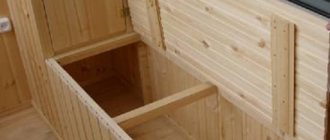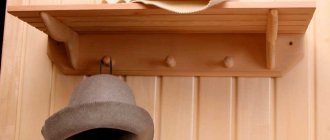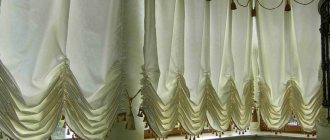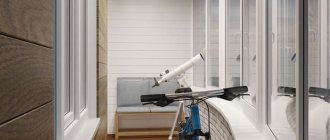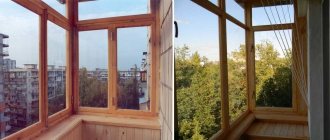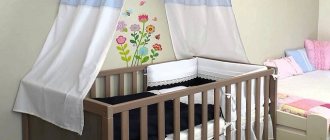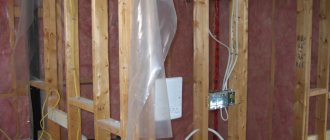Humanity has come up with thousands of simple and convenient things that help organize our lives. And if we talk about non-living home helpers that make everyday chores easier, then it’s time to think about the clothes dryer.
A DIY clothes dryer may be simple, but it is definitely useful and necessary, since washing is an almost daily “concern” for us, and the laundry itself needs to be dried somewhere.
Fortunately, the clotheslines hung all over the city with laundry floating on them, hanging out for the neighbors and street passers-by to see, are a thing of the past. Today, clothes dryers are easy-to-use, compact and functional designs that allow maximum saving of living space in apartments and balconies.
The variety of modern devices for drying clothes and other things is simply amazing, so anyone can choose an “assistant” to suit their needs and requirements. We will try to review the possible options, and even talk about how to make a clothes dryer with your own hands and what materials are suitable for this.
Options by location
First of all, let's decide what space in the apartment can be used for drying clothes. It’s good if your apartment has a balcony, even better if it is equipped or at least glazed - usually this is one of the most suitable rooms for drying things.
The air there is usually fresher than, for example, in the kitchen, and there is less humidity than in the bathroom, with the exception of rainy weather, of course. However, in the bathroom, in the living room, and even in the corridor, drying clothes is also quite acceptable: everything will depend on the model of the device, its design and its location.
So, let’s look at what dryers are by location:
1. Floor-standing – this is, as a rule, a portable folding structure that does not require additional fastening, since when unfolded it is a device resting on legs, which, by the way, are equipped with plastic wheels for ease of movement.
They can be horizontal, vertical (maximum saving of usable space), multi-tiered and electric (ideal for quick drying). Convenience and practicality lies in the fact that you unfold the dryer when you need it and install it on the floor where there is currently free space.
After the laundry has dried, fold it and hide it in a closet, on the mezzanine, etc. Floor-standing models generally have so-called “wings” in their design, which can significantly increase the area for hanging wet things, shoes, and bedding. If when folded the width of the device is approximately 5-7 cm, then when unfolded it has an area of about 1.5 square meters.
Undoubtedly, these structures are indispensable for small apartments, in a more aggravated version without a balcony: because they hung laundry on it at night while everyone was sleeping and it didn’t bother anyone, and in the morning they got up, took off dry things and hid it “out of sight” .
I would also like to say that the variety of floor-standing models offered by modern manufacturers is so great, and their prices are so affordable, that making a floor-standing clothes dryer with your own hands seems to be an irrational activity, unless “tinkering” is your favorite hobby.
Also read on our website: Ceiling clothes dryer for the balcony. Overview of options
2. Wall-mounted – such models can be permanent (rigidly attached to the wall) or mobile (removable). The former are beneficial to use in the bathroom or on the balcony, the latter become an interesting option in terms of installing them on radiators using a special mount.
Rigid mount models can be:
- sliding in the form of an “accordion” or with retractable grooves;
- exhaust, consisting of two parts, attached to opposite walls;
- folding ones, which when assembled are adjacent to the wall;
- so-called “vines” made of rods and cords, fastened to brackets, etc.
The latter are often referred to as ceiling-wall models, so we will talk about them in more detail below. Unfortunately, regardless of the option, all of them are not designed for large volumes and weight of laundry: they are mainly intended for children's clothes, socks, towels or shoes.
3. Ceiling - the most popular and most used designs, characterized by the ability to hang a large volume of washed items on them.
Their main advantage is the fact that when they are not wearing underwear, they are practically invisible, unless, of course, you specifically raise your head to detect them. Basically, these devices are designed for installation on a balcony; the main thing is to correctly think through their location relative to the windows and the balcony door, so that subsequently the device does not interfere with the free opening and closing of the latter.
There are many types of ceiling structures, and this is the best opportunity to make a clothes dryer for your balcony with your own hands, exactly the way you like it. Therefore, we propose to talk about these devices and their homemade versions in more detail.
Ceiling varieties
Source: stroiremdoma.ru
As a rule, dryers that can be installed under the ceiling are considered the most convenient. Let's take a quick look at their merits. Firstly, they do not steal space, and secondly, they are less noticeable than those located at eye level and below. Secondly, the laundry dries faster - after all, we all remember that warm air accumulates at the top.
The disadvantages include the fact that such dryers must be mounted on the ceiling or on the walls next to it, which is not always convenient. In addition, not all surfaces are suitable for this. For example, such manipulations are strictly contraindicated for a suspended ceiling.
However, if such disadvantages are not a problem for you, you can choose the system to your liking. There are several types of such structures:
- stationary - always located in the place where they were originally installed. In principle, the ropes we are familiar with are just a stationary system. For installation, brackets are fixed on two opposite walls, and cords are fixed on them, on which clothes will be dried. Of course, the cheapest thing would be to just buy two brackets and a rope, but it won’t look very aesthetically pleasing. Therefore, we recommend purchasing even such a simple system in a complete set in a store. At the same time, you can choose a better material and an appearance that will best suit the decor of the room. In any case, the cost of even a ready-made system is not that high, it varies from approximately 700 to 2000 rubles,
- sliding - also, in fact, stationary, but only partially fixed in one place, since they also have a removable element. In this case, the non-removable block is fixed on one wall, and the fasteners for the removable one are on the opposite wall. When not in use, such a dryer is very compact; all the strings are hidden inside it. To operate, you just need to pull out the removable block, pull it to the opposite wall and fix it there using the installed fasteners. Systems can be either single cord or multi-cord, so you can choose the one that best suits your family's needs. The cost of a sliding dryer is low. But there is one drawback: this design often breaks under heavy loads. That is, for example, a large terry sheet can be hung there only with great caution,
- folding - they can “migrate” along the surface of the ceiling; if there is no need, they simply fold up, thereby freeing up space. The system consists of several rods connected by movable bars. Usually the structure is folded in the form of an accordion, and before direct use the whole thing can be easily pulled apart. Moreover, the folding system can be either manual or automatic. In addition, some manufacturers equip such dryers with lighting lamps and other useful devices. Of course, such designs no longer belong to economy class; their cost varies from tens of thousands of rubles and more,
- Liana is a favorite option for many, allowing for variable placement of the structure and is very convenient to use. The great advantage of this dryer is that the drying clothes can be placed almost close to the ceiling. Therefore, it does not dangle at waist level and is not as in the way as on other dryers, which are located quite low. At this point, many short housewives may ask incomprehensibly: “Then how to hang the laundry?” Let's explain. The peculiarity of the design is that the cord system can be lowered to the level that is convenient for you. Having lowered them, you can fix them and calmly hang the laundry, and then raise everything to the height, again, that you need. Moreover, the cords can be fixed at different heights, for example, in the form of a ladder. This often helps the laundry dry faster. Of course, this system is not without its drawbacks. Firstly, the design has quite large dimensions, so its presence cannot be hidden. But it looks quite aesthetically pleasing, and again, it doesn’t take up too much space when drying clothes. Secondly, hanging a vine is not so easy. The standard kit consists of two roller brackets, long and short strings (cords), metal or plastic cylinders, special caps, and brackets for fixation. All this needs to be assembled into a single mechanism, and also securely fastened, so at least minimal experience is required here.
We've sorted out the ceiling structures, let's move on to the next type.
Types of ceiling devices
The types of these devices may differ both in design features and in the method of fastening, the material used, and capacity.
The main designs that are most popular with homeowners include the following:
- Stationary - the simplest and cheapest option for a dryer: the design of which consists of brackets rigidly fixed to the ceiling and ropes, cords or slings stretched over them. The disadvantage of the design is the impossibility of adjusting the height and length of the ropes on which the “wash” is hung, and if they are located high, you will have to use a stool or bench each time, which is not very convenient;
- Telescopic - refers to sliding models, the peculiarity of which is that their elements extend from each other, according to the principle of a spyglass. The advantage is the fact that it is possible to change the length, height and distance between the strings;
- Retractable – reminiscent of an accordion, they are a fairly spacious system;
- Sliding - is a cantilever device consisting of a frame with cords attached to it, where the height can be adjusted within a range of half a meter, which is a clear advantage for the convenience of hanging washed items;
- Dryer-liana – quite complex in terms of installation, a stationary structure consisting of tubes (rods) connected to fastening blocks with slings. Advanced functionality allows you to adjust the height of the rods using a special mechanism located on the wall. Another advantage of the design is the fact that the dried items will not have creases, as after drying on cords or ropes, due to the diameter of the pipe (rod). The device can withstand up to 20 kilograms of laundry.
Recently, the functionality of dryers has been expanded thanks to technological innovations, so new, more modern models have appeared:
- Multi-tiered - this is when a removable part is added to the stationary classic version, consisting of many strips fastened with metal fasteners;
- Articulated – is a device made of profiles fixed to the ceiling, with a roller system for height adjustment, usually includes elements as “hangers” for linen;
- Automated – a model of this design is very durable: it can withstand up to 28-30 kilograms of wet laundry, is equipped with additional fans to speed up the drying process and has a remote control unit.
Different types of dryers
Sliding dryer
Related article: Knitted items in apartment interior decor
According to their design, dryers are divided into:
- stationary;
- with sliding mechanism;
- prefabricated
If you don’t want to drill into the walls and ceiling of your balcony, then in this case it is best to use sliding and folding dryers. They can be set out for drying clothes at any time, and after fulfilling their function, they can be folded and placed in any secluded place in the apartment. So, let’s take a closer look at the design principle of some of their types.
Sliding
This product is similar in design to a tape measure. If necessary, it can be expanded and then collapsed back. Its device includes the following elements:
- the main mount, which is securely attached to the wall at the required height;
- a body in which the strings are wound in a device. If necessary, they are straightened;
- fastening, which is located on the opposite side. With its help, the dryer is fixed in working condition.
Folding
Folding dryers are divided into two types according to the method of their assembly. Some of them fold in width, but mostly in length.
When unfolded, they should be secured using special brackets.
When purchasing a folding dryer, you should pay attention to the material from which it is made. Crossbars for drying clothes should be made of strings or thin pipes.
The cheapest designs are made of aluminum. But this material cannot withstand heavy loads and over time the pipes begin to sag.
The most reliable option is a stainless steel product. It has a high degree of strength and will last a long time. But the cost will be considerable.
If you need a small dryer, you can purchase one made of plastic. But it should be remembered that such a dryer can also withstand not too much load. Before purchasing, be sure to check the specifications provided by the manufacturers.
Ceiling
The design of the ceiling dryer is a little more complicated than those discussed earlier. Its basis consists of a body, which is attached directly to the ceiling. Using special rollers, pipes are attached to the body.
Related article: How to lengthen curtains with your own hands - 6 ways
There is a rope inside them. Using it, we adjust the tension and height, and then lock the dryer in the configured position using a special locking element. This type of design is one of the optimal ones for use on a balcony or loggia.
The quality of such a dryer also depends on the material from which it is made. The most reliable and durable is stainless steel.
Wall-mounted
One of the common types is wall structures. They are quite practical and cheap. They are composed of the following elements:
- The main body that is attached to the wall.
- In the middle of the body there is a drum on which a rope is wound;
- There are hooks in the upper part, to which unwound ropes are attached.
The advantages of this design include:
- compactness. If the structure is not used, the ropes are wound up and do not interfere with the residents;
- small price.
Rope dryers begin to sag
But, unfortunately, they have many disadvantages:
- short-lived - the ropes begin to sag quite quickly.
- cannot withstand heavy loads - up to a maximum of 6 kg of laundry.
Recently, wall-mounted dryers in the form of an accordion have gained significant popularity. This is a cantilever-type structure that slides apart and assembles. The maximum width in working condition reaches about half a meter. Very compact and convenient for use for balconies with a small area. Able to withstand loads from 6 to 10 kg.
What are ceiling dryers made of?
As already mentioned, there are no difficulties in making a clothes dryer with your own hands, especially if we are talking about a ceiling model. You just need to first figure out what materials can be used for this depending on their performance characteristics.
Also read on our website: Wardrobe for the balcony: types, materials, sizes, placement
So, the most suitable ones would be:
- Tree - environmentally friendly, easy to process, does not require complex tools, affordable in terms of cost and offers, the main disadvantage of which can be its low moisture resistance, even when treated with special compounds, it can swell with constant contact with wet laundry;
- Stainless steel - has very high strength and resistance to moisture, but also has the disadvantage of being very massive; when attached to the ceiling, the latter will bear a significant load, so if the reliability of the ceiling is in doubt, it is better to choose a lighter material, and in addition, tools will be required for processing for metal;
- Plastic is very light, inexpensive, practical, but fragile and has very little strength, so if you expect to need to dry large things (blankets, duvet covers, jackets), then it is better to abandon it in favor of a more durable material;
- Aluminum is light and convenient, but bendable, fragile and often oxidizes, and is also not very suitable for DIY processing.
When deciding which material to choose for making the frame, you should also think about the volume of things you will have to dry (some people live alone, while others have a large family), what size space you expect to occupy for installing the dryer, not forget to calculate your strengths and skills, as well as whether you have the necessary tools for processing.
Outdoor
There are several options that can be made.
Many people prefer to install this device outside.
In order to make an external one, the following materials are needed:
- drill;
- dowels;
- metallic profile;
- metal square with drilled holes for rope;
- clothesline.
First of all, a metal profile is attached on both sides, the length of which is equal to the width and length of the dryer. The profile must be well fixed; it must easily withstand the weight of wet laundry. After this, a square is attached to it and a strong rope is threaded through the holes. The optimal distance between the ropes is approximately 15 cm, and the length is 4-5 rows.
If the balcony structure is built-in, then the dryer can be installed directly on the load-bearing wall using self-tapping screws. To do this, use special brackets with holes or rollers for ropes. Another option could be a retractable one, which can be folded out only when necessary.
Outdoor structures have undoubted advantages - drying clothes in the fresh air and free space. However, it is not very convenient to use in the cold season; in addition, street dust and precipitation falling on washed items can stain them again.
What are the requirements?
Despite the fact that we are talking about simple structures, they must still have certain quality characteristics, which include:
- Ability to withstand weight depending on the operational needs assigned to them, but not less than 5 kg;
- Fastenings should be easy to use, but reliable enough so that the structure does not collapse on the residents’ heads;
- Structural elements should not be subject to rust, so as not to dirty things;
- If possible, it is necessary to calculate the height of the structure in such a way that you do not have to climb onto the bench to hang things.
Also read on our website: How to arrange a balcony or loggia
Time to tinker
Let's look at the simplest option for arranging a ceiling dryer on the balcony with your own hands, for which we will need a drill, a hammer drill and a screwdriver from the tools, and from the materials we will take a rope, wooden planks in the section 50x20 and a dozen self-tapping screws-rings.
We will carry out the work in the following sequence:
- To begin with, we will cut the strips to the required length, depending on the calculated width of the future dryer, and clean the surfaces;
- Let's make markings on the slats for the holes on the basis that where we will then attach the screw-rings, the distance between the holes will be about 8-10 cm (usually the width of the dryer is 50-60 cm, so we will get 5 holes each), and We mark the holes that will serve us for fastening to the ceiling along the edges.
- Using a drill, we drill holes to the required diameter, but do not forget that the holes for the ring screws should be smaller in diameter than the diameter of the screws;
- Before continuing to work with the planks, they must be varnished or painted;
- We screw self-tapping rings into the drilled holes and be sure to check the strength of the connection, make sure that they can withstand the weight of the laundry;
- Attach the slats to the ceiling and make markings along the prepared holes that are intended for attaching them to the ceiling;
- Using a hammer drill, make holes in the ceiling, remove the strips and install dowels;
- Using screws, secure the planks to the ceiling;
- Attach the cord to one of the outer rings from the self-tapping screw and pull it through all the other rings.
This way you will get a simple and inexpensive design that you can make yourself.
If the ropes sag over time, they can be easily adjusted by simply untying one end and tightening them. A very interesting option could be a dryer made from hangers, especially since things dry much faster on hangers.
You can even use just a durable bathroom curtain with a cornice as holders. Of course, you won’t be able to hang bed linen on such a drying rack, but it’s a very good option for shirts and blouses.
Craftsmen with enviable imagination manage to make a sock dryer from an old umbrella - the result is a completely simple and at the same time original type of drying device.
Another interesting variation for setting up a clothes dryer on the balcony is to hang a light ladder from the ceiling, the slats of which will serve as elements on which you can hang both clothes and bed linen. You can also attach hooks to it or attach “hangers” for clothes.
As you can see, there are a lot of options for arranging a ceiling clothes dryer, both industrially produced and homemade. And since it is simply impossible to do without such a house design, every owner has every chance to buy or make a model that is suitable specifically for his needs, which will become truly useful, functional and convenient.
